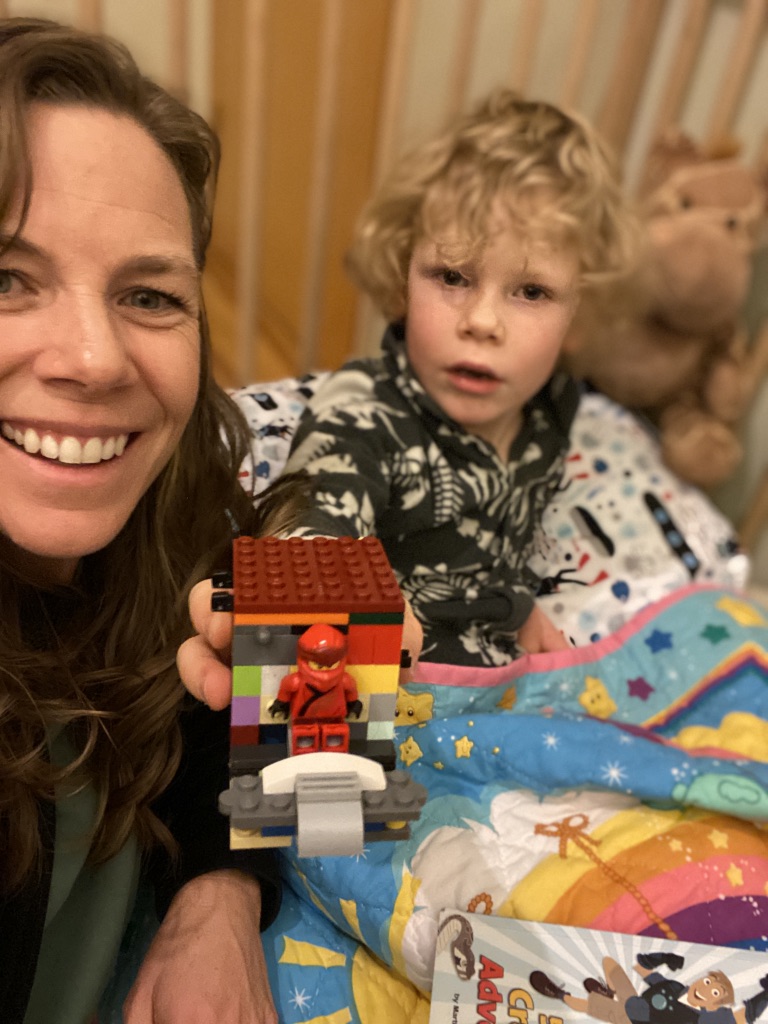Life on Abram Lake
Life as a rural physician Mama in the backwoods of Northwestern Ontario
You can’t act right if you don’t feel right.
“Dr. Sprague, call from the Regional Phones doc! I’m transferring it back to you,” shouts the ER clerk. I grab the receiver as my cellphone concurrently alarms in my scrub pocket. ‘Shit, it’s the radiologist likely calling me about the CT head results for Room 5,’ I internally grumble. Tethered to the landline, I toss my cell at one of the nurses, “Tell him I’ll just be 3 minutes.” Head pressed to the phone, I listen to my physician colleague on the other end tell a familiar story: “Sending a patient down to you. 35-year-old male, IV drug use, presenting with fever, back pain. Doing labs, starting him on Vanco, but he’ll need a CT to rule-out an epidural abscess.” “Ok, got it. Sounds good,” I reply, my eyes trained on the Trauma room ahead of me. Through the glass window of the doctor’s charting area, I squint to make out the stats on the monitor above the bed. Numbers in blue and red tell another story of the patient lying in the gurney below. Her expression is obscured by an obscenely large mask that covers her nose and mouth, strapped tightly against her face. A tube connects the mask to a ventilator, pushing oxygenated air into her lungs with her every breath. Uncontrolled diabetes, end-stage kidney disease and congestive heart failure – a deadly trifecta so often seen in our ER. As her kidneys fail, fluid builds up in her lungs and the already stressed heart slowly packs it in. She’s sick and I’m worried. I do my best to manage her failing body and pray that the ICU calls me back sooner rather than later.
I take the next call from the Radiologist. A subdural hematoma; bleeding between the layers that envelope the brain. ‘Well, shit,’ I curse again, ‘that will need a call to the neurosurgeon in Thunder Bay and likely transfer out.’ I grab the patient’s chart off the rack and quickly scan the department before I get back onto the phone.

As usual, the ER is full to the brim. As the receiving centre for our local community of five thousand, as well as our catchment area which provides service to 33 Anishinaabe communities and some 40,000 people living in fly-in-access only Nations across Northwestern Ontario, our rural, family medicine-run hospital sees it all. From the North, our patients are triaged in the nursing stations to be the sickest of the sick. These patients fly in a near-constant stream via air ambulance to our little ER. The result is a high volume, high acuity department staffed by three nurses and one family physician. No consultant physicians nearby, no ICU, no respiratory therapists, no mental health specialists. Our nearest tertiary care centres are hundreds of kilometres away; to the East, in Thunder Bay and to the West, in Winnipeg. It’s a rewarding, but also challenging and often terrifying place to work.



Stretchers line the hallways of our tiny shop: a kidney infection in S1, alcohol withdrawal in S2, back pain needing morphine and likely admission in S3. The isolation room holds a young woman actively miscarrying at twelve weeks awaiting a lifesaving OR procedure to stop her heavy bleeding. The nurses cajole and beg her to not leave for a smoke. She’s indifferent, marching to the exit with a cigarette at her lips dragging her IV pole behind her. The nurses look at me, ‘Do something about this,’ they appeal with their eyes. I motion for the security guard to accompany her and continue to take stock of the flooded department.
Room 1: Elder, failure to cope at home, needing admission. Room 2: 5-month-old baby with a fever. Waiting for me to assess. Room 3: A hockey-loving teen with a possible broken wrist. X-rays ordered. Room 4: Another patient on a BiPap ventilator; her diaphragm unable to overcome the weight of her morbidly obese frame as carbon dioxide builds up in her bloodstream. Waiting for repeat labs. Room 5: Subdural hematoma. (Shit, I still have to call neurosurgery!) Assessment Room: a suicidal 15-year-old girl with a hard gaze. On a Form 1, awaiting transfer to psychiatry. The list goes on.


To my right, the box that holds patient charts awaiting to be seen by me overflows, clipboards piled high, spilling onto the floor. My stomach grumbles and contracts. I can tell the nurses are tense and patients are angry at the wait, lashing out at the support staff. “I’ve been waiting here for hours! When am I gonna get seen!? This place is fucked,” I hear someone yell as the door to triage opens to the full waiting room.
I feel my own anger boil up. I’m overwhelmed and recognize the familiar sense of burnout as I shift the blame of a struggling system onto the patient for their illness. Before I can make another move, the clerk grabs my attention yet again. Another phone call from the Regional Phones doctor requesting another Medivac to be sent to me. This time, it’s a young woman presenting to the nursing station after her third near-fatal suicide attempt in as many months. “She needs physician assessment and then probably can just go to out-patient counselling,” my colleague suggests.
Then, I break. It happens swiftly, uncontrollably. “Out-patient counselling?!,” I bark. “She’s going to need to be Formed! And obviously sent to Psych. Have you even called them yet?” I’m yelling into the phone, my face flushed. “You don’t have to be angry, you know,” my colleague retorts. My knuckles are white, gripping the receiver. “Just send her,” I manage to sputter as I slam the phone down, instantly feeling the shame wash over me. I have never spoken to a colleague this way before in my entire career. I squeeze my eyes shut and plead for the universe to swallow me whole.
The beeping of the two ventilators continues to fill the space in my brain, incessant.

Backtrack to the summer of 2019 and I am on a glorious solo trip in Toronto to attend a wellness conference hosted by the Canadian Women in Medicine Association. The conference boasted a very non-conventional agenda focusing on leadership, sex, parenting and self-care. I had also chosen to attend a pre-conference workshop specifically on parenting of little ones. Up until that point, I had been fumbling along in my journey as a parent to Henry (then 4 years) and Alice (3 years). Unlike my role as a physician, there was no lengthy training, no years of study, no exams and no dedicated immersion into the topic; one day I wasn’t a mother and then the next, I was.

In front of me stood a slight woman in her 50s, unruly brown hair framing her expressive face. Speaking enthusiastically with a New York accent, she bounced around the stage, arms waving wildly. At that time, I was (and still am!) thick in the season of daily parenting battles with my littles. I clung to her every word like a lifeline. I had no idea that the next few hours would drastically change my approach to parenting.
Over the three-hour workshop, Joanna Faber, co-author of ‘How to Talk so Little Kids Will Listen’ dropped pearl after pearl as I scribbled furiously on scraps of paper. One statement, however, struck me profoundly:
“Kids can’t ACT right if they don’t FEEL right”.
It was so simple but the clarity of her message was like an awakening. Kids aren’t inherently bad when they are acting out. Instead, they may be struggling with big emotions, hungry or tired. “Think of how difficult it is to keep your cool when YOU are tired/hungry/under pressure,” Faber carried on. I nodded empathically. I thought of all of the times I had lost my temper on the kids while gripped with anxiety about work or when I hadn’t acted my best with a colleague or patient when I was simply burnt out; exhausted, out of empathy and out of patience.


Up until that workshop, my approach to getting through the daily grind was a combination of pleading, bribing and threats (depending on how desperate I was feeling at that moment). If you are a parent of littles, you can empathize with the sheer frustration and anger that arises with the constant ‘No’s’ that you face at every turn.
“Henry, can you please go for a pee before bed?”
“No! I need to finish my LEGO creation. I don’t want to go to bed! Nooooooo!”
“Alice, can you please eat your dinner? Alice, please eat your dinner! ALICE, EAT YOUR DINNER PLEASE!”
“No, no, no! I don’t want to! No! It’s yuck! I don’t like it.”
Every. Step. Of. The. Way.
I often think of what life would be like if I just asked once, and they just miraculously did what I asked. Imagine! But alas, with two young spirited kids, life wasn’t as smooth as I wanted it to be.
These daily struggles with the kids were causing much frustration amongst all of us. Every relationship in our family was being affected. Blake and I would fight, exhausted and wound tight after 45 minutes of begging, theatrics, threats and bribes just to get a few bites of dinner into them each night. Even the dog would run off to the neighbour’s to escape the chaos of the morning hustle out the door.
There had to be a better way. How could I engage the kids to encourage connection and cooperation? How could I resolve the constant conflicts without punishments, threats and yelling?
The following tools from Faber and King’s “How to Talk so Little Kids Will Listen” have been instrumental in navigating the minute-to-minute outbursts from Alice and Henry. I hope that in sharing Faber’s pearls from her workshop and from her book can help you as they have helped me.
Faber’s method is grounded in the acknowledgement of the child’s feelings. “Without acknowledging,” Faber explains, “you’re working against yourself.” Seems simple enough, but how often do we truly support our kid’s perspective? In our house, our constant morning struggle with Henry is always centred around him not wanting to go to school. So engrossed in building LEGO ‘creations’, each morning is the same. “I don’t want to go to school! I hate school!” How quickly do we default to our immediate gut reactions: “You love school! Don’t say hate” (denial of feelings), or “Your friends all love school!” (comparisons), or “Why don’t you like school!?” (questions), or “Life is hard, sometimes you have to do things you don’t want to do” (advice/lecturing), etc.
Think of when you get home from a shitty day at work. You bust through the door and let it all out to your partner and he or she counters with similar responses – lectures, advice, telling us to suck it up, other people have it harder, etc. We would be PISSED OFF and likely storm away. What we often need is someone to just simply acknowledge how we feel. Responses from your partner which might be better-received could be: “Man that sucks! What a crappy day. Sounds brutal. Ugh!”
A mega pearl from Faber’s workshop that has stuck with me was that if you’re not sure how to respond to your child’s emotions, try it on yourself first. Remember, nothing is more infuriating than being told to calm down when you’re angry or being subjected to a philosophical lecture when you’re losing your cool about how a colleague acted at work.
How to handle emotions:
- Acknowledge feelings with words. All feelings must be accepted, some actions must be limited. Resist the immediate urge to counter. Sit on the BUTS! Try, ‘The problem is…’ instead. Name the feeling. Be DRAMATIC. Match the child’s emotion. Be genuine and real. Resist the urge to ask questions while the child is in distress.
- Acknowledge feelings with writing. Have your little one write a wish list that facilitates acceptance of feelings while limiting actions. Our kids are still too little, so often they dictate and I write it down.
- Acknowledge feelings with art. Have your child draw a picture of how they feel.
- Give in fantasy what you cannot give in reality. I often will take a picture with my phone for their ‘wish list’. I don’t actually manifest this wish list into anything, but they always feel validated when I do this.
- Acknowledge feelings with (almost) silent attention. “Ugh!” “Mmmm” “Ohh”
Although I’m far from perfect, I use ALL of the above tools on the daily. When Henry starts up, whining, “I don’t want to go to schoooooooool!” although I’m irritated and annoyed, I often grit my teeth, force my face to smile and say, “Man! You really don’t want to leave your LEGOs. You’re in the middle of creating a cool jet plane. You wish you could play LEGO all day, all night and NEVER go to school EVER. You’re so ANGRY (with an angry face, hands clenched) about having to go to school every day! UGH!!!!!”
Often this results in an empathic nodding and a big hug, then we carry on with the morning routine which goes much more smoothly than had I responded with, “Henry, just pull yourself together. You know that have to go to school! Why do we have to go through this EVERY SINGLE DAY!” It’s not perfect by any stretch, but it does help.


But, beyond learning how to navigate these huge emotional eruptions, what I really wanted to know from Faber’s workshop was how the hell do I get my kids to listen to me?! I feel like my mind is literally going to explode if I have to ask them to get their boots on one more time.
Pertaining to getting our kids to do as they are told, Faber initially described the reality of the child vs. the reality of the parent. To us, we are CONSTANTLY nagging our kids to do all of the things that they just have to do! But think about your kids. Their whole day is filled with being told what to do by adults. No one likes to be ordered around, myself included. Anytime someone tells me I have to do something, my immediate reaction is to balk and do the opposite. Sound familiar?!
Here are Faber’s tools for Engaging Cooperation:
- Be Playful. Turn a task into a game. This sounds exhausting, but Faber gave a life-changing point – kids are inherently exhausting! It’s more fun when we’re all tired and cheerful instead of tired and irritable. Why not try to make it a bit more enjoyable?
- Offer a choice. We all like to feel that we have some control and autonomy!
- Put the child in charge. Delegate! You’ll be surprised at what they will be able to accomplish. Kids are generally wired to please.
- Give information. Not a lecture, but explain simply why you’re asking them of something. Keep it brief.
- Say it with a word or a gesture. This saves the lecture that no one wants to listen to. Try to use a noun, not a verb. Jacket! Hat! Toothbrushing gesture.
- Describe what you see and forego the command. Appreciate the progress before pointing out what is left to be done.
- Describe how you feel. Express your anger or frustration with using ‘I’, rather than ‘you’. I love this one – it helps me when I’m so irritated. Instead of yelling “Don’t hit Alice! You are acting terribly tonight!” I try, “I DO NOT LIKE TO SEE KIDS GETTING HURT! I GET VERY UPSET TO SEE HITTING!”
- Write a note.
- Take action without insult. This one is huge. I’ve been reading a lot of Brene Brown’s work on shame which is inherently linked to one’s self-worth. Of course, we must limit some actions, but instead of shaming our kids (“You’re so bad! You’re a bad listener!”), try taking action without insulting your child (“I see you’re having a hard time containing all of that energy. Let’s read together rather than jumping from the couch onto the counter.”)

In real life, these tools don’t come easily. I’ve attended Faber’s workshop, listened to the audiobook AND have read the text twice and still I struggle. Two nights ago, I was at the dinner table with the kids. Blake was away so I was already feeling slightly overwhelmed. Henry was pent up with energy from his chaotic day at school. He was all over the place, jumping around in his seat, putting his feet on the table and generally pushing all of my buttons. HARD.

I have to be brutally honest here. There are times like this when I have to actively resist the physical temptation to grab him, haul him into his room and hit him. Yikes. It’s so scary to admit that in writing. But I do feel this way, especially if I’m not ‘feeling right’ myself.
At this particular occasion, I was doing all of my default parenting moves. “If you sit and eat quietly, you can watch ‘Wild Krats’ after dinner!”, and “If I see your feet on the table one more time, there will be no more dessert for you”, and “Please sit down! On your bum! Henry, on your bum! HENRY!” Nothing was working and I was losing… losing the battle and my mind along with it.
Then, I literally got out my phone and swiped to Faber’s “How to Talk” app, outlining all of the aforementioned tools. I took a breath and tried a different approach.
“I see socks on the table. I feel upset when stinky socks are on the table!” (describing how you feel), then “SOCKS!”, “STINKY FEET!” (saying it with a word). No luck. I tried again. “Henry, your feet are so full of sillies tonight. The problem is, feet do not belong on the table” (giving information). Still no luck. By this point, I’m seriously gritting my teeth and wishing that I had more of a stockpile of wine in the house. I went at it one more time. “Oh my goodness those socks are being so silly tonight. Henry, can you be in charge of keeping them dangling down?” (putting the kid in charge). Finally! The ticket. He pretended to be the ‘parent’ and scolded his feet and kept them off the table. Whew.

Next, after learning about dealing with big emotions and getting kids to cooperate, Faber went on to speak about resolving conflict. As parents, we are always disciplining our kids. In our house, that often looks like time-outs and removal of privileges (i.e. ‘No show tonight!’, ‘No dessert for you!’). But Faber had lots to say about those techniques. Oops. Guess I won’t be up for parent of the year!
“Punishment,” Faber explained, “can achieve quick results, but not without pitfalls. Punishment can cause escalating use of force. With punishing, your only recourse if it doesn’t work is punishing HARDER. Punishing doesn’t allow the child to fix the behaviour. When we put a child in a time-out, they don’t learn, instead, it allows for fixation on selfish thoughts that breeds resentment. They generally stew, feel angrier and more upset. Finally, kids who are bullied often become bullies themselves. We have to ask ourselves if we want our kids to use these methods on their peers and siblings. Remember, children will do as you DO, not as you SAY.”
This hit very close to home. I am constantly at our kids to treat others as they would want to be treated themselves. But, if our discipline strategy is focused on punishment, they are learning that when faced with a conflict, their only strategy is to inflict hurt or sadness on another. Faber also went on to empathize that if we train our kids that anytime they do something wrong, their parents will come at them heavy-handed and they will be much less likely to reach out when something bad happens in the future (i.e. teen years).
Hmmmm, ok so what are different strategies to handle things with your kid does something clearly ‘wrong’. I feel like I’m constantly disciplining one of the kids for fighting with their sibling. It’s exhausting.
Here are Faber’s tips to Resolving Conflict:
- Express your feelings strongly. Again, I love this, because it does allow me to get some of my own irritation out. “I DON’T LIKE IT WHEN I SEE KIDS PUSHING!” Focus on using ‘I’, rather than ‘you’.
- Show the child how to make amends. Instead of making the child feel worse by lashing out, teach them how they can make their sibling and themselves feel better.
- Offer a choice. Tell them what they CAN do instead of what they can’t.
- Take action without insult. Above all else, protect people and property. Remove the object causing the conflict or leave the environment causing the fight.
- Problem solving. This is a tool to use after the storm has passed. Maybe on a completely separate day when you have time and space to sit down with your child as this is a more involved process.
- Start by acknowledging the child’s feelings
- Describe the problem (briefly, don’t lecture)
- Ask for ideas, make a list and include them ALL
- Decide which ideas you can both agree on
- Try out your solutions
Again, this all seems to involve a LOT of time and energy and it does. There are definitely more circumstances in which I find myself resorting to inflicting time-outs than patiently working through the steps of a brainstorming session. BUT, the thing about parenting is that you can mess up and still have ENDLESS opportunities to try again. At our house, I mess up seemingly hundreds of times each day, but when we do get it right and things work out, it feels like the highest victory a parent can achieve.
So, Godspeed to all of the parents out there. You’re not alone. It’s ok to struggle but I hope some of Faber and King’s tools can help you to struggle just a tiny bit less. Good luck!











Thank you Celia for your words, they sure hit home for me at my house. I do feel like I’m failing my boys, but I am going to try those suggestions you mentioned, and buy the book!
LikeLike
Hi Shannon – you certainly are NOT failing your kiddos! The fact that you are even considering other parenting strategies is an exemplification that you are a caring and loving parent who is doing her best. I hope you find the book as helpful as it has been for me! Best of luck.
LikeLike